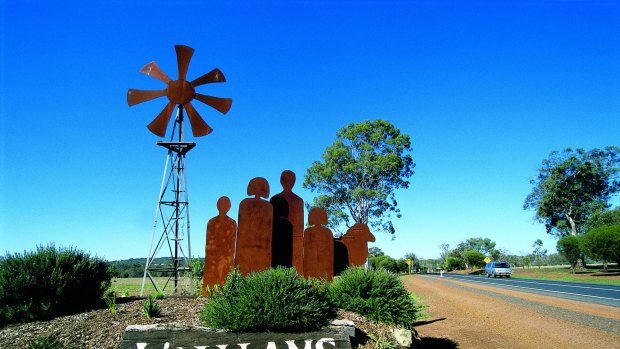This was published 10 years ago
Williams, Western Australia: Travel guide and things to do

The entrance statement to the town of WilliamCredit: Tourism Western Australia
Williams is located 161 km south of Perth. It is a small settlement with a town population of about 450, a rural population of 800, and an average rainfall of 546 mm per annum. The main industries in the district are wool, wheat, oats and hay with a little bit of beef.
The area around Williams was first explored by Europeans in 1831 when Captain Thomas Bannister led the first overland expedition from Perth to King George III Sound (Albany). It is likely that Bannister named the river after King William IV.
Bannister¹s party blazed the track which became the basis for the Old Sound Road which was used until a more direct route was taken through the present Williams townsite in 1857.
The earliest claims on the land along the Williams River occurred in 1832. These claims were not matched by settlement. In 1836 Lieutenant Henry Bunbury explored the Williams River and upon his return he declared that he had Œpassed through a wretched country with neither water nor feed: on the Williams the land is generally very bad and the water brackish.¹
This negative assessment seemed to make no impression on potential setters. The district¹s first settler was Joseph Strelley Harris, who, in the same year as Bunbury¹s doleful assessment of the area, drove 300 sheep and some cattle from York to his father¹s property at Williams. In 1839 Harris was the first to drive sheep overland from King George III Sound to Williams. Although it seemed that the arrival of sheep would ensure the rapid development of the area the problem of poisonous plants (at least three were identified) proved to be problematic and the early development of the town was based more on the traffic passing along the road than the agricultural produce of the area.
The first bridge over the Williams River was built by convicts in 1855 and as travel between Perth and Albany increased so did the Williams township. The town quickly became one of the major stopover points on the coach road from Perth to Albany.
The Williams River Bridge Hotel was opened in 1870 on the site of the present hotel and the townsite was surveyed in 1905. The reason for this relatively late decision to survey the town was that the original town grew up on the Albany side of the river. As the land in the district was cleared the Williams River became more prone to flooding and so the whole town was moved to the Perth side and the new townsite was surveyed in 1905.
Today Williams is a convenient stopping place for travellers.
Things to see
Williams Heritage Trail
There is an excellent Williams Heritage Trail brochure available at the Roadhouse. It details a total of 19 places of historical interest in the local area. Of these places the most interesting are the old Agricultural Hall (1898) on the Albany Highway which is now used as an Arts and Crafts shop, the superb old Williams Hotel (1871) recognised as the oldest building in town, and the very unusual convict tank, a 4 500 litre capacity underground tank which was built by ticket-of-leave men in the 1880s. The tank is located near the river on the Albany side of town.
Tourist information
Tourist Information Centre (Shire Offices)
Brooking St
Williams WA 6391
Telephone: (08) 9885 1005
Sign up for the Traveller Deals newsletter
Get exclusive travel deals delivered straight to your inbox. Sign up now.